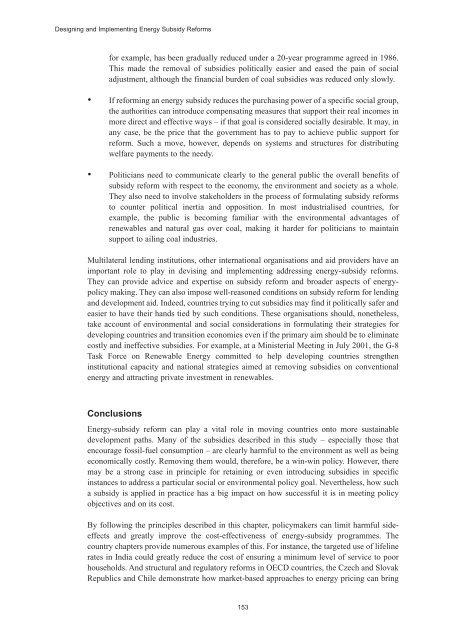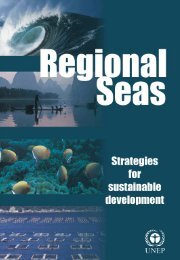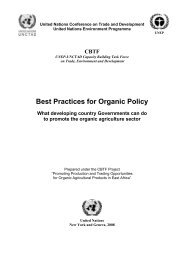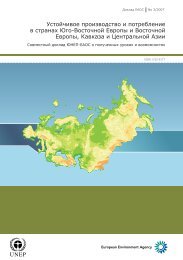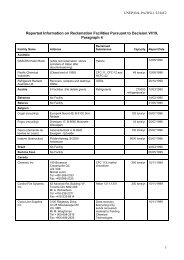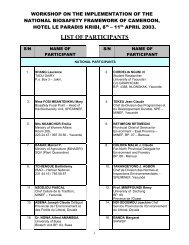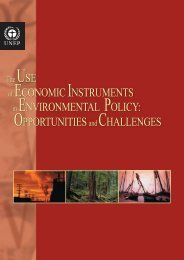Energy Subsidies: Lessons Learned in Assessing their Impact - UNEP
Energy Subsidies: Lessons Learned in Assessing their Impact - UNEP
Energy Subsidies: Lessons Learned in Assessing their Impact - UNEP
Create successful ePaper yourself
Turn your PDF publications into a flip-book with our unique Google optimized e-Paper software.
Design<strong>in</strong>g and Implement<strong>in</strong>g <strong>Energy</strong> Subsidy Reforms<br />
for example, has been gradually reduced under a 20-year programme agreed <strong>in</strong> 1986.<br />
This made the removal of subsidies politically easier and eased the pa<strong>in</strong> of social<br />
adjustment, although the f<strong>in</strong>ancial burden of coal subsidies was reduced only slowly.<br />
• If reform<strong>in</strong>g an energy subsidy reduces the purchas<strong>in</strong>g power of a specific social group,<br />
the authorities can <strong>in</strong>troduce compensat<strong>in</strong>g measures that support <strong>their</strong> real <strong>in</strong>comes <strong>in</strong><br />
more direct and effective ways – if that goal is considered socially desirable. It may, <strong>in</strong><br />
any case, be the price that the government has to pay to achieve public support for<br />
reform. Such a move, however, depends on systems and structures for distribut<strong>in</strong>g<br />
welfare payments to the needy.<br />
• Politicians need to communicate clearly to the general public the overall benefits of<br />
subsidy reform with respect to the economy, the environment and society as a whole.<br />
They also need to <strong>in</strong>volve stakeholders <strong>in</strong> the process of formulat<strong>in</strong>g subsidy reforms<br />
to counter political <strong>in</strong>ertia and opposition. In most <strong>in</strong>dustrialised countries, for<br />
example, the public is becom<strong>in</strong>g familiar with the environmental advantages of<br />
renewables and natural gas over coal, mak<strong>in</strong>g it harder for politicians to ma<strong>in</strong>ta<strong>in</strong><br />
support to ail<strong>in</strong>g coal <strong>in</strong>dustries.<br />
Multilateral lend<strong>in</strong>g <strong>in</strong>stitutions, other <strong>in</strong>ternational organisations and aid providers have an<br />
important role to play <strong>in</strong> devis<strong>in</strong>g and implement<strong>in</strong>g address<strong>in</strong>g energy-subsidy reforms.<br />
They can provide advice and expertise on subsidy reform and broader aspects of energypolicy<br />
mak<strong>in</strong>g. They can also impose well-reasoned conditions on subsidy reform for lend<strong>in</strong>g<br />
and development aid. Indeed, countries try<strong>in</strong>g to cut subsidies may f<strong>in</strong>d it politically safer and<br />
easier to have <strong>their</strong> hands tied by such conditions. These organisations should, nonetheless,<br />
take account of environmental and social considerations <strong>in</strong> formulat<strong>in</strong>g <strong>their</strong> strategies for<br />
develop<strong>in</strong>g countries and transition economies even if the primary aim should be to elim<strong>in</strong>ate<br />
costly and <strong>in</strong>effective subsidies. For example, at a M<strong>in</strong>isterial Meet<strong>in</strong>g <strong>in</strong> July 2001, the G-8<br />
Task Force on Renewable <strong>Energy</strong> committed to help develop<strong>in</strong>g countries strengthen<br />
<strong>in</strong>stitutional capacity and national strategies aimed at remov<strong>in</strong>g subsidies on conventional<br />
energy and attract<strong>in</strong>g private <strong>in</strong>vestment <strong>in</strong> renewables.<br />
Conclusions<br />
<strong>Energy</strong>-subsidy reform can play a vital role <strong>in</strong> mov<strong>in</strong>g countries onto more susta<strong>in</strong>able<br />
development paths. Many of the subsidies described <strong>in</strong> this study – especially those that<br />
encourage fossil-fuel consumption – are clearly harmful to the environment as well as be<strong>in</strong>g<br />
economically costly. Remov<strong>in</strong>g them would, therefore, be a w<strong>in</strong>-w<strong>in</strong> policy. However, there<br />
may be a strong case <strong>in</strong> pr<strong>in</strong>ciple for reta<strong>in</strong><strong>in</strong>g or even <strong>in</strong>troduc<strong>in</strong>g subsidies <strong>in</strong> specific<br />
<strong>in</strong>stances to address a particular social or environmental policy goal. Nevertheless, how such<br />
a subsidy is applied <strong>in</strong> practice has a big impact on how successful it is <strong>in</strong> meet<strong>in</strong>g policy<br />
objectives and on its cost.<br />
By follow<strong>in</strong>g the pr<strong>in</strong>ciples described <strong>in</strong> this chapter, policymakers can limit harmful sideeffects<br />
and greatly improve the cost-effectiveness of energy-subsidy programmes. The<br />
country chapters provide numerous examples of this. For <strong>in</strong>stance, the targeted use of lifel<strong>in</strong>e<br />
rates <strong>in</strong> India could greatly reduce the cost of ensur<strong>in</strong>g a m<strong>in</strong>imum level of service to poor<br />
households. And structural and regulatory reforms <strong>in</strong> OECD countries, the Czech and Slovak<br />
Republics and Chile demonstrate how market-based approaches to energy pric<strong>in</strong>g can br<strong>in</strong>g<br />
153


